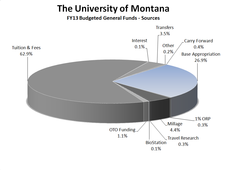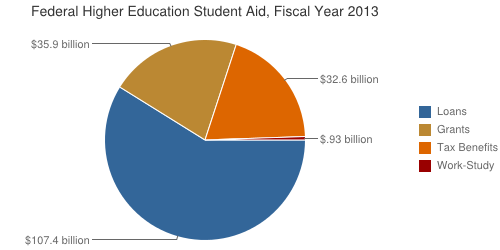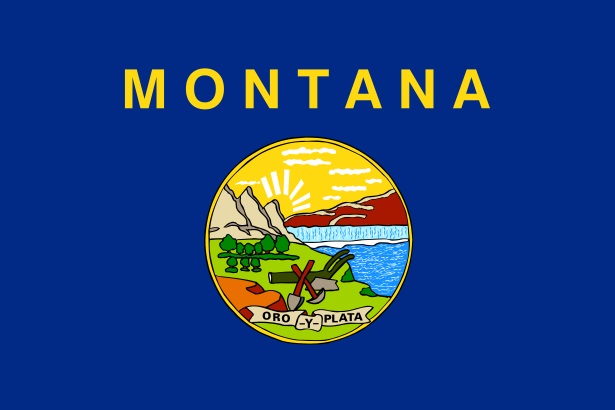 The University of Montana
The University of Montana Let’s take a look, shall we?
The UM General Fund: Students and Legislators
 2013 UM Budget
2013 UM Budget The University of Montana’s funding comes from its general fund budget. A third of that comes from the Montana Legislature while two thirds come from tuition and fees paid by students.
Both of those funding mechanisms are tied to enrollment, so if there are fewer students there’s less money, and that means the university runs into problems. We began to see this in January with the $9 million budget deficit the University of Montana was trying to deal with.
The deficit may since have fallen around $6 million. So that means UM is short $6 million on their $160 million general fund budget for 2014. The whole operating budget for 2014 is $420 million, but the general fund is what UM really has to ‘play around with.’
In 2009 the operating budget for UM was $345 million. It continued to rise as more students enrolled, with enrollment reaching a peak of 15,669 in 2011, according to the Missoulian.
And that’s one of the reasons so many more faculty members were hired. That year the general fund for UM was $135 million, with $45 million coming from the legislature and $90 million from students.
Of course when the university gets in the news for high-profile rape cases, enrollment tends to drop, and we new see the current problems – too much staff, not enough money coming in from the legislature or the students.
The UM President’s Pay
 President Royce Engstrom
President Royce Engstrom The university rationalizes this exorbitant package because it keeps costs involved with president turnover down. Considering that the previous president, George Dennison, was at UM for two decades, I’m just not sure president turnover is an issue.
Sheila Stearns, Montana’s Commissioner of Higher Education, had this to say back in 2010 when that pay package was first being put together:
"It's hard for people to understand that it has a business and educational advantage, but there's no doubt in my mind," she said. "People don't give unless they know well the person with whom they're giving. For a president, even one who doesn't golf, to get out there and spend time with men and women in the community ... building relationships, there's clear evidence, and not just in Montana" that it has a positive influence on the university they represent, Stearns said.
After all, UM would want to raise costs for students, wouldn’t they? It’s where 2/3 of their budget is coming from!
How You and Students Suffer
 No money for local economy
No money for local economy Students suffer because costs continue to rise for them and they have to take out more student loans. You suffer when they graduate and they can’t put money into the economy each month, only to student loans.
Take a look at our doctors. The average medical school graduate is getting out of school with $200,000 in debt. Of course they’re going to go into the big-money fields like plastic surgery for Hollywood starlets. General practitioners or orthopedic surgeons? Not so much. Good luck finding one of those orthopedic surgeons in Helena – you’ve got to wait 6 to 8 weeks.
So because of this massive student loan debt these young doctors have to forgo needed medical fields in favor of those that may not be needed and certainly aren’t essential.
Now take that and translate it into all sector of the economy. Business majors will flock to Wall Street for easy earnings at the expense of millions of Americans.
Instead of shoveling that money into some rainy day fund so these guys can buy ever-larger houses in Missoula’s South Hills – before they transfer to a larger school to repeat the process – shouldn’t we give that money to students?
Solutions for UM Funding Woes

First, students shouldn’t pay more, as we just saw with student loans. Next, the legislature can pay more, but there’s no say in where that money goes or what it’s spent on.
There is no oversight. The board of regents says where the money can go, and that’s why we see so many high salaries, and perhaps so many low adjutant and assistant professorial salaries as well.
Are you telling me there’s not dozens of people here in Missoula that would love to have UM president Engstrom’s job? And are you telling me many of those same people can’t do twice the job at half the cost?
And don’t forget the sixteen faculty department administrators making more than $100,000 a year. Most of those are in the, you guessed it, Business Department.
Huh, Montana hasn’t been labeled a very friendly state for businesses, and yet the people teaching our graduates are making so much. What the hell are they teaching up there?
I just don’t understand it, but right now we’ve got some problems and they need solutions.










